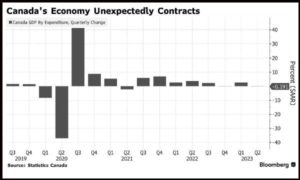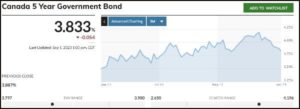Real estate listings in the country’s largest metro areas continued to grow in September while buyer demand is trending downward.
The shifting market dynamic was so pronounced in the greater Vancouver and Toronto areas that they are now officially in a buyer’s market.
New listings in the GTA were up 44% in September to a total of 16,258 properties. The increase was even more pronounced in the city’s downtown condo market where listings are up 50% compared to last year.
Listings were also up in other cities, but to a lesser degree, including Vancouver (+28%), Calgary (+21%) and Ottawa (+10%).
“The most striking trend that emerged in recent months has been the return of sellers to the housing market,” noted RBC’s Robert Hogue. “The factors driving this trend are many but soaring interest costs no doubt are prompting a growing number of owners to move.”
Analyst Ben Rabidoux of Edge Realty Analytics notes that Toronto’s new listings are now “well above” typical levels, which has pushed the sales-to-new listings ratio down to levels not seen since the Financial Crisis in 2008.
“This market is severely tilted towards buyers, and it looks like significant price declines are on deck,” he wrote in a note to clients.
Expect this trend to continue
Hogue says the trend of growing inventory and falling prices is likely to continue as long as interest rates remain high and continue to impact affordability.
“We expect little change in this broad picture in the months ahead. We think buyers will stay on the defensive in many parts of Canada despite more choice becoming available to them,” he wrote, adding that high interest rates, ongoing affordability issues and a looming recession are “poised to pose major obstacles.”
“Any material acceleration in the market recovery will have to wait until interest rates come down in 2024,” he added.
Regional housing market roundup
Here’s a look at the September statistics from some of the country’s largest regional real estate boards:
QUICK LINKS:
*********
Greater Toronto Area

| September 2023 | YoY % Change | |
| Sales | 4,642 | -7.1% |
| Benchmark price (all housing types) | $1,119,428 | +3% |
| New listings | 16,258 | +44.1% |
| Active listings | 18,912 | +39.8% |
“GTA home selling prices remain above the trough experienced early in the first quarter of 2023. However, we did experience a more balanced market in the summer and early fall, with listings increasing noticeably relative to sales,” said TRREB chief market analyst Jason Mercer.
“This suggests that some buyers may benefit from more negotiating power, at least in the short term. This could help offset the impact of high borrowing costs.”
Source: Toronto Regional Real Estate Board (TRREB)
Greater Vancouver Area

| September 2023 | YoY % Change | |
| Sales | 1,926 | +13.2% |
| Benchmark price (all housing types) | $1,203,300 | +4.4% |
| New listings | 5,446 | +28.4% |
| Active listings | 11,382 | +9.2% |
“A key dynamic we’ve been watching this year has been the reluctance of some homeowners to list their homes given that mortgage rates are the highest they’ve been in over 10 years,” said Andrew Lis, REBGV Director of Economics and Data Analytics.
“With fewer listings coming to the market earlier this year than usual, inventory levels remained very low, which led prices to increase throughout the spring and summer months.”
Source: Real Estate Board of Greater Vancouver (REBGV)
Montreal Census Metropolitan Area

| September 2023 | YoY % Change | |
| Sales | 2,738 | +9% |
| Median Price (single-family detached) | $549,000 | +3% |
| Median Price (condo) | $402,000 | +6% |
| New listings | 5,872 | +2% |
| Active listings | 16,398 | +10% |
“The Montreal CMA market continued to stabilize in September, with transactional activity comparable to that of a very quiet month of August. If sales are up compared to the same period last year, it is because 12 months ago activity had started to drop towards an all-time low,” said Charles Brant, Director of the QPAREB’s Market Analysis Department.
“While the economic context is deteriorating against a backdrop of persistent inflation, the new wave of interest rate hikes at the start of summer translated into a more cautious approach by buyers in September,” he added. “For their part, sellers are trying to cash in their added value while market conditions, supported by a solid migratory flow, are still favourable to them.”
Source: Quebec Professional Association of Real Estate Brokers (QPAREB)
Calgary

| September 2023 | YoY % Change | |
| Sales | 2,441 | +29% |
| Benchmark price (all housing types) | $570,300 | +8.7% |
| New listings | 3,191 | +21.6% |
| Active listings | 3,369 | -24.5% |
“Supply has been a challenge in our market as strong inter-provincial migration has elevated housing demand despite higher lending rates,” said CREB Chief Economist Ann-Marie Lurie. “While new listings are improving, it has not been enough to take us out of sellers’ market conditions.”
Source: Calgary Real Estate Board (CREB)
Ottawa

| September 2023 | YoY % Change | |
| Sales | 946 | No change |
| Average Price (residential property) | $675,412 | +2.7% |
| Average Price (condominium) | $425,968 | +1% |
| New listings | 2,259 | +9.8% |
| Active listings | 2,997 | +14% |
“Sales activity came in right on par with where it stood at the same time last year but was still running well below typical levels for a September,” said OREB President Ken Dekker.
“New listings have surged in the past several months, which has caused overall inventories to begin gradually rising again. However, available supply is still low by historical standards, and we have ample room to absorb more listings coming on the market,” he added. “Our market is also right in the middle of balanced territory, and while MLS Benchmark prices are down from last year they are still trending at about the same levels from 2021.”
Source: Ottawa Real Estate Board (OREB)
This articel was written for Canadian Mortgage Trends by:





